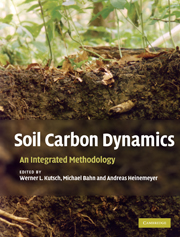Book contents
- Frontmatter
- Contents
- List of Contributors
- Preface
- Editorial Acknowledgements
- 1 Soil carbon relations: an overview
- 2 Field measurements of soil respiration: principles and constraints, potentials and limitations of different methods
- 3 Experimental design: scaling up in time and space, and its statistical considerations
- 4 Determination of soil carbon stocks and changes
- 5 Litter decomposition: concepts, methods and future perspectives
- 6 Characterization of soil organic matter
- 7 Respiration from roots and the mycorrhizosphere
- 8 Separating autotrophic and heterotrophic components of soil respiration: lessons learned from trenching and related root-exclusion experiments
- 9 Measuring soil microbial parameters relevant for soil carbon fluxes
- 10 Trophic interactions and their implications for soil carbon fluxes
- 11 Semi-empirical modelling of the response of soil respiration to environmental factors in laboratory and field conditions
- 12 Modelling soil carbon dynamics
- 13 The role of soils in the Kyoto Protocol
- 14 Synthesis: emerging issues and challenges for an integrated understanding of soil carbon fluxes
- 15 Appendix: Towards a standardized protocol for the measurement of soil CO2 efflux
- Index
- References
14 - Synthesis: emerging issues and challenges for an integrated understanding of soil carbon fluxes
Published online by Cambridge University Press: 11 May 2010
- Frontmatter
- Contents
- List of Contributors
- Preface
- Editorial Acknowledgements
- 1 Soil carbon relations: an overview
- 2 Field measurements of soil respiration: principles and constraints, potentials and limitations of different methods
- 3 Experimental design: scaling up in time and space, and its statistical considerations
- 4 Determination of soil carbon stocks and changes
- 5 Litter decomposition: concepts, methods and future perspectives
- 6 Characterization of soil organic matter
- 7 Respiration from roots and the mycorrhizosphere
- 8 Separating autotrophic and heterotrophic components of soil respiration: lessons learned from trenching and related root-exclusion experiments
- 9 Measuring soil microbial parameters relevant for soil carbon fluxes
- 10 Trophic interactions and their implications for soil carbon fluxes
- 11 Semi-empirical modelling of the response of soil respiration to environmental factors in laboratory and field conditions
- 12 Modelling soil carbon dynamics
- 13 The role of soils in the Kyoto Protocol
- 14 Synthesis: emerging issues and challenges for an integrated understanding of soil carbon fluxes
- 15 Appendix: Towards a standardized protocol for the measurement of soil CO2 efflux
- Index
- References
Summary
INTRODUCTION
In view of a rapidly changing climate system the terrestrial carbon cycle has received an increasing amount of attention over the last two decades, both from scientists and the public. Much progress has been made on characterizing the net exchange of CO2 between terrestrial ecosystems and the atmosphere (NEE) (Baldocchi et al., 2001; Schimel et al., 2001; Chapin et al., 2006; Friend et al., 2007; Luyssaert et al., 2007; Baldoochi et al., 2008). However, to improve our estimates of the carbon sequestration potential of ecosystems and to be able to project current flux observations into the future, it is important to obtain a better understanding of the component fluxes of NEE, and how they are regulated in response to changing environments. Our knowledge of the assimilatory component of the carbon cycle (i.e. photosynthesis) is well advanced both at the leaf and the canopy level (Farquhar et al., 1980; de Pury and Farquhar, 1997). In contrast, there are still substantial gaps in our understanding of the respiratory component, which is a major determinant of ecosystem carbon balance (Valentini et al., 2000; Huxman et al., 2003; Luo and Zhou, 2006; Trumbore, 2006). Even though emissions of CO2 from soils globally constitute the second largest flux of carbon between terrestrial ecosystems and the atmosphere (Raich and Schlesinger, 1992; Schlesinger and Andrews, 2000), their potential response to global change is still largely assessed on the basis of simplistic assumptions and relationships (for recent critical reviews cf. Davidson and Janssens, 2006; Davidson et al., 2006; Högberg and Read, 2006; Trumbore, 2006).
- Type
- Chapter
- Information
- Soil Carbon DynamicsAn Integrated Methodology, pp. 257 - 271Publisher: Cambridge University PressPrint publication year: 2010
References
- 6
- Cited by

